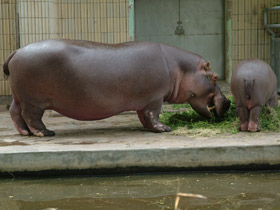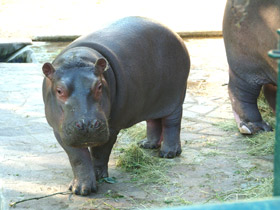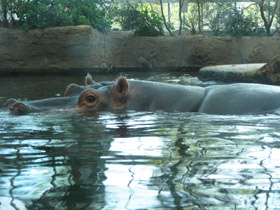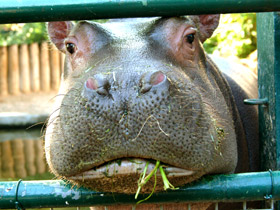The hippopotamus Hippopotamus amphibius
The Hippopotamidae is a small family containing only two extant species, both of which are distributed in African continent.
The hippopotamus (Hippopotamus amphibius), or hippo, is one of the largest living terrestrial animals; weight of the older males may be more than 4 tones, and body length, 3.5 m. Previously the pigs were thought to be closest relatives of the hippopotamuses, but recent study demonstrated that the hippopotamuses are rather related to the Cetaceans. And indeed, the hippopotamuses are actually semi-aquatic animals as they spend most of their life in water and come out to the land only for a few hours in the nights, when they are foraging. It is not surprising that ancient Greeks called them “river horses” (Greek translation for “hippopotamus”), the Arabs knew them by the name “river buffalos”, and they had even more accurate name in Egypt – “river hogs”. The hippos can spend up to half an hour under water, though they usually stay submerged for only three or five minutes. They swim paddling with their short hind legs, but more often they just navigate on the shallow river bottoms using the advantage of their huge weight. The have barrel-shaped body and very short and thick legs: each of the webbed feet has four toes covered with hooves. The weight of the huge, massive head of the “river buffalo” reaches one third of the total weight of the animal (up to 900 kg); nostrils, eyes and ears are located in the same plane, on top of the head allowing these animals to remain mostly submerged while still being able to breathe, see and hear (Photo 3). The hippo’s small eyes are partly covered with thick eyelashes, while very wide, directed upwards nostrils can close due to the fleshy edges and special, well-developed muscles. The skin of this animal is almost hairless and has mucous glands that secret fluid of unusual red colour; for years this fluid was called “blood sweat.” This specific mucous fluid gives hippo’s skin resilience, protects it from the sun and prevents its swelling when the animal is staying in the water. The hippo has a unique mouth: the jaws are capable of opening up to 150 degrees; teeth are widely spaced, the lower canines do not have roots, grow during the whole life of the animal, and can reach the length of 65 cm. Their diet consists mostly of juicy plants growing along the river beds. The hippos may eat as much as 40 kg per day. Their extremely long digestive tract (about 60 cm) and three-chambered stomach allow for fermentation of bulky cellular masses.
The hippopotamuses live in groups of one adult male and 10 to 12 females with their offspring. Solitary males stay separately; they are quite aggressive and often fight each other, producing loud roars, demonstrating threatening poses and standing in front of each other with widely opened mouths. Gestation period in females is about eight months, after which the female gives birth to a single calf while staying in shallow water. The mother should help her baby to rise over the water surface and make its first breath; otherwise the calf may choke because the baby hippos are not capable of holding their breath for more than 40 seconds. In five minutes after birth the little hippo weighing just about 50 kg, can stand and in 24 hours it follows its mother (Photos 1 and 2). It is amazing that a baby hippo can suck milk not only on the land but also in the water – while doing so, it shuts its nostrils and tightly presses its ears against the head (apart from the hippos, only of aquatic mammal babies – Cetaceans and Sirenians – are capable of doing the same). The hippo calf starts teething on the forth month of age, and gradually learns to feed on various plants from the age of five months though it is not weaned until the age of one year. Young hippo stays with its mother till the birth of her next baby, and sometimes even longer.



















































